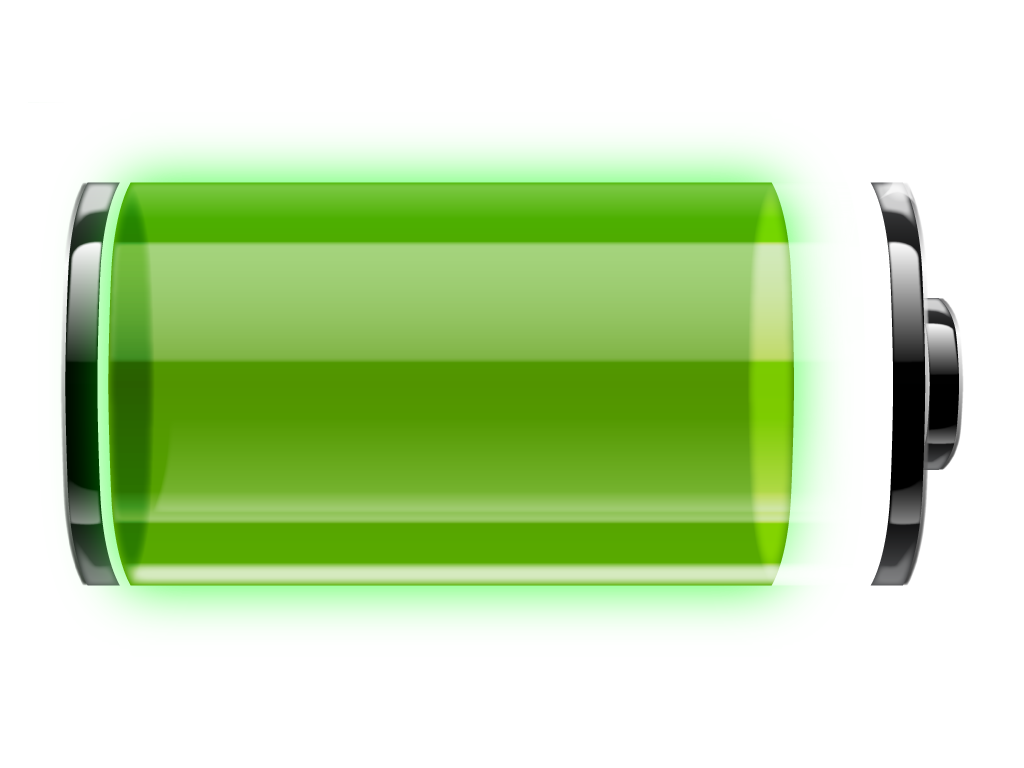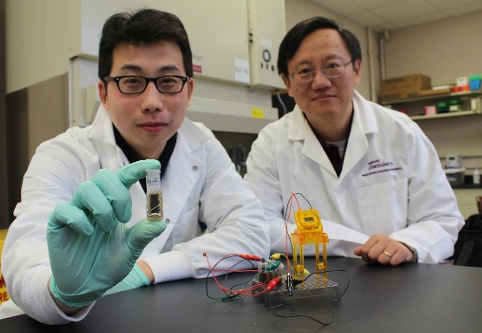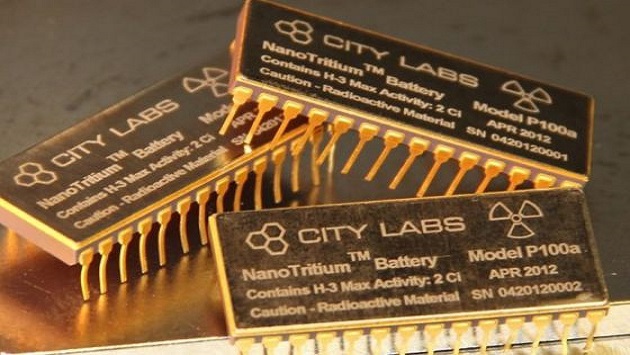Review of new technologies in the production of food sources
The current month turned out to be a good one for battery developers. In various sources, the news about new products in this industry appears every now and then. I decided to collect information about them and share with you. Under the cat you will find many different energy storage technologies - from sugar to quantum.

From 26 to 28 February, an exhibition of storage takes place in Tokyo, at which, among others, Micronics Japan Co. is represented . Ltd. About her previous developments, little is known, but more recently she said that she had developed and prepared a new type of layered battery for production. The single cell, which the company demonstrates, is a film of n-type metal-oxide-semiconductor structure, which uses particles of titanium dioxide, tin dioxide and zinc oxide, covered with an insulating film. The prototype uses a 10 micron thick stainless steel sheet, but it will soon be replaced with aluminum.
Quantum developers have named their battery to emphasize its physical, not chemical nature. Despite the fact that electrons are used instead of ions for storing energy, according to the principle of operation, this battery differs from capacitors. It is argued that the system is based on the storage of electrons "in the forbidden zone" of a semiconductor.
')

In the production of metal-oxide-semiconductor structures, the charge layer of the storage ring is irradiated with ultraviolet light. After fabrication, during charging, the electrons occupy free energy levels in the working material and are stored there until the battery needs to be discharged. The result is rechargeable batteries with a very high energy storage density.
What indicators have test samples unknown, but the developer states that serial samples that will appear in the near future, will have a capacity of up to 500 Wh / l and at the same time will be able to produce up to 8,000 watts of peak power per liter of volume.
Such drives combine the best features of batteries and supercapacitors. Even with a small capacity, they will be able to produce more peak power. The voltage taken from such drives does not decrease as they discharge, but remains stable to the end.
The stated operating temperature range is from -25 to +85 ° C. A battery can be subjected to 100 thousand charge-discharge cycles before the capacity drops below 90% of the original. The ability to quickly pick up and release energy will greatly reduce the charging time. In addition, these batteries are fireproof. Rare or expensive materials are not used in its production. In general, there are so many advantages that I can hardly believe it.
A group of researchers led by Zhonglin Wang (Zhong Lin Wang) from the Georgia Institute of Technology (USA) has created a self-charging battery that does not require a connection to the outlet to resume charging.
The device is charged by mechanical stress, or rather by pressing. It is planned to be used in smartphones and other devices of touch devices.
The developers placed their device under the keys of the calculator and were able to ensure its operability during the day due to the energy from pressing the buttons.

The battery is a “prirog” of polyvinylidene fluoride and zirconate-titanate-lead films with a thickness of several hundred micrometers. When you press it, lithium ions migrate from the cathode to the anode due to the piezoelectric effect. To improve the efficiency of the prototype, the researchers added nanoparticles to its piezoelectric material, enhancing the corresponding effect, and achieved a serious increase in the capacity and speed of recharging the device.
You need to understand that the battery is opaque, so it can be placed only under the buttons or under the screen.
The battery does not have such outstanding characteristics as the previously described device (now the battery capacity of the size of a standard tablet for matplat has grown from the initial 0.004 to 0.010 mAh), but the developers are promised to work on its effectiveness. Industrial designs are still far away, although flexible screens - the main devices in which the developer plans to deploy his battery - are still not widely distributed. There is still time to modify your invention and introduce it into production.
It seems that only Asians are engaged in the development of batteries. The prototype of the next unusual battery created in the American Polytechnic University of Virginia.

This battery essentially works on sugar, more precisely on maltodextrin, a polysaccharide obtained by hydrolysis of starch. The catalyst in this battery is an enzyme. It is much cheaper than platinum, which is now used in conventional batteries. This battery belongs to the type of enzyme fuel cells. Electricity is produced here by the reaction of oxygen, air and water. Unlike hydrogen fuel cells, enzymes are incombustible and non-explosive. And after the battery has exhausted its resource, according to the developers , it can be refilled with sugar again.
Little is yet known about the technical characteristics of this type of battery. It is stated only that the energy density in them is several times higher than in conventional lithium-ion batteries. The cost of such batteries is significantly lower than normal, so the developers are full of confidence to find commercial use of them in the next 3 years. Let's wait for the promised.
But scientists from the American National Acceleration Laboratory SLAC at Stanford University have decided to increase the volume of conventional batteries , using the structure of a grenade.

The developers reduced the size of the anodes as much as possible and placed each of them in a carbon envelope. This helps prevent their destruction. In the process of charging, the particles expand and join into clusters, which are also placed in the carbon shell. As a result of such manipulations, the capacity of these batteries is 10 times the capacity of conventional lithium-ion batteries.
From the experiments, it follows that after 1000 charge / discharge cycles, the battery retains 97% of the original capacity.
But it is too early to talk about the commercial use of this technology. Silicon nanoparticles are too expensive to manufacture and the process of creating such batteries is too complex.
And finally, talk about the development of British scientists . They decided to outdo their colleagues by creating a miniature nuclear reactor. The prototype atomic battery, created by researchers at the University of Surrey on the basis of tritium, produces enough energy to operate a mobile phone for 20 years. True recharge it later will not work.

In the battery, which is an integrated microcircuit, a nuclear reaction takes place, as a result of which 0.8 to 2.4 watts of energy is produced. Battery operating temperature ranges from -50 to +150. Moreover, she is not afraid of sudden changes in temperature and pressure.
The developers claim that for a person tritium, which is contained in the battery is not dangerous, because its content there is very small. However, it’s too early to talk about mass production of such power sources - scientists still have a lot of research and testing to do.
Of course, not all of the above technologies will find their application, however, we must understand that in the next few years a breakthrough should occur in the production technology of rechargeable batteries, which will lead to a surge in the spread of electric vehicles and the production of smartphones and other electronic devices of a new type.

"Quantum" battery
From 26 to 28 February, an exhibition of storage takes place in Tokyo, at which, among others, Micronics Japan Co. is represented . Ltd. About her previous developments, little is known, but more recently she said that she had developed and prepared a new type of layered battery for production. The single cell, which the company demonstrates, is a film of n-type metal-oxide-semiconductor structure, which uses particles of titanium dioxide, tin dioxide and zinc oxide, covered with an insulating film. The prototype uses a 10 micron thick stainless steel sheet, but it will soon be replaced with aluminum.
Quantum developers have named their battery to emphasize its physical, not chemical nature. Despite the fact that electrons are used instead of ions for storing energy, according to the principle of operation, this battery differs from capacitors. It is argued that the system is based on the storage of electrons "in the forbidden zone" of a semiconductor.
')

In the production of metal-oxide-semiconductor structures, the charge layer of the storage ring is irradiated with ultraviolet light. After fabrication, during charging, the electrons occupy free energy levels in the working material and are stored there until the battery needs to be discharged. The result is rechargeable batteries with a very high energy storage density.
What indicators have test samples unknown, but the developer states that serial samples that will appear in the near future, will have a capacity of up to 500 Wh / l and at the same time will be able to produce up to 8,000 watts of peak power per liter of volume.
Such drives combine the best features of batteries and supercapacitors. Even with a small capacity, they will be able to produce more peak power. The voltage taken from such drives does not decrease as they discharge, but remains stable to the end.
The stated operating temperature range is from -25 to +85 ° C. A battery can be subjected to 100 thousand charge-discharge cycles before the capacity drops below 90% of the original. The ability to quickly pick up and release energy will greatly reduce the charging time. In addition, these batteries are fireproof. Rare or expensive materials are not used in its production. In general, there are so many advantages that I can hardly believe it.
Self-charging battery
A group of researchers led by Zhonglin Wang (Zhong Lin Wang) from the Georgia Institute of Technology (USA) has created a self-charging battery that does not require a connection to the outlet to resume charging.
The device is charged by mechanical stress, or rather by pressing. It is planned to be used in smartphones and other devices of touch devices.
The developers placed their device under the keys of the calculator and were able to ensure its operability during the day due to the energy from pressing the buttons.

The battery is a “prirog” of polyvinylidene fluoride and zirconate-titanate-lead films with a thickness of several hundred micrometers. When you press it, lithium ions migrate from the cathode to the anode due to the piezoelectric effect. To improve the efficiency of the prototype, the researchers added nanoparticles to its piezoelectric material, enhancing the corresponding effect, and achieved a serious increase in the capacity and speed of recharging the device.
You need to understand that the battery is opaque, so it can be placed only under the buttons or under the screen.
The battery does not have such outstanding characteristics as the previously described device (now the battery capacity of the size of a standard tablet for matplat has grown from the initial 0.004 to 0.010 mAh), but the developers are promised to work on its effectiveness. Industrial designs are still far away, although flexible screens - the main devices in which the developer plans to deploy his battery - are still not widely distributed. There is still time to modify your invention and introduce it into production.
Sugar based battery
It seems that only Asians are engaged in the development of batteries. The prototype of the next unusual battery created in the American Polytechnic University of Virginia.

This battery essentially works on sugar, more precisely on maltodextrin, a polysaccharide obtained by hydrolysis of starch. The catalyst in this battery is an enzyme. It is much cheaper than platinum, which is now used in conventional batteries. This battery belongs to the type of enzyme fuel cells. Electricity is produced here by the reaction of oxygen, air and water. Unlike hydrogen fuel cells, enzymes are incombustible and non-explosive. And after the battery has exhausted its resource, according to the developers , it can be refilled with sugar again.
Little is yet known about the technical characteristics of this type of battery. It is stated only that the energy density in them is several times higher than in conventional lithium-ion batteries. The cost of such batteries is significantly lower than normal, so the developers are full of confidence to find commercial use of them in the next 3 years. Let's wait for the promised.
Battery with garnet structure
But scientists from the American National Acceleration Laboratory SLAC at Stanford University have decided to increase the volume of conventional batteries , using the structure of a grenade.

The developers reduced the size of the anodes as much as possible and placed each of them in a carbon envelope. This helps prevent their destruction. In the process of charging, the particles expand and join into clusters, which are also placed in the carbon shell. As a result of such manipulations, the capacity of these batteries is 10 times the capacity of conventional lithium-ion batteries.
From the experiments, it follows that after 1000 charge / discharge cycles, the battery retains 97% of the original capacity.
But it is too early to talk about the commercial use of this technology. Silicon nanoparticles are too expensive to manufacture and the process of creating such batteries is too complex.
Nuclear batteries
And finally, talk about the development of British scientists . They decided to outdo their colleagues by creating a miniature nuclear reactor. The prototype atomic battery, created by researchers at the University of Surrey on the basis of tritium, produces enough energy to operate a mobile phone for 20 years. True recharge it later will not work.

In the battery, which is an integrated microcircuit, a nuclear reaction takes place, as a result of which 0.8 to 2.4 watts of energy is produced. Battery operating temperature ranges from -50 to +150. Moreover, she is not afraid of sudden changes in temperature and pressure.
The developers claim that for a person tritium, which is contained in the battery is not dangerous, because its content there is very small. However, it’s too early to talk about mass production of such power sources - scientists still have a lot of research and testing to do.
Conclusion
Of course, not all of the above technologies will find their application, however, we must understand that in the next few years a breakthrough should occur in the production technology of rechargeable batteries, which will lead to a surge in the spread of electric vehicles and the production of smartphones and other electronic devices of a new type.
Source: https://habr.com/ru/post/214047/
All Articles